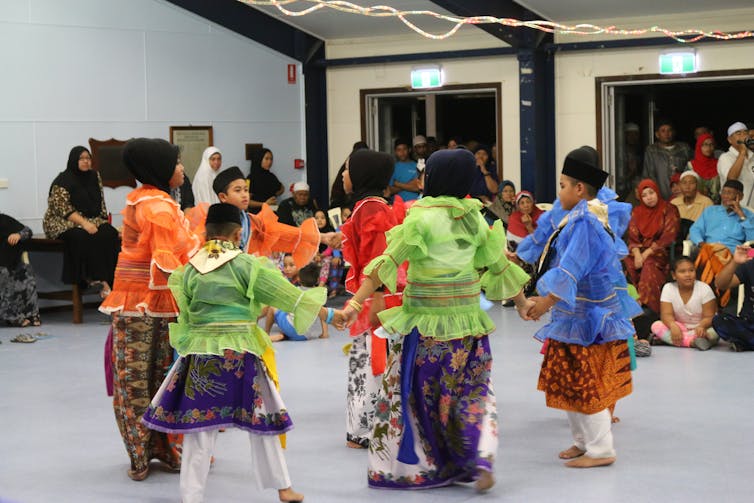In 1826, an English merchant, Alexander Hare, brought a group of people from Malaysia and Indonesia as well as South Africa and New Guinea to an atoll northwest of mainland Australia in the Indian Ocean. Hare took them to the Cocos (Keeling) Islands as indentured workers, slaves and/or convicts. A year later, a Scottish rival, Clunies Ross, took over.
His subjects became known as “Cocos Malays”. During the 150-year rule of the Clunies Ross dynasty, the Cocos Malays developed a unique culture and dialect. They adopted Scottish jigs and music in their performance repertoire. Still living on their island home, the Cocos Malays are now Australian citizens. Some seek recognition from the Australian government as “Indigenous”.
A recent documentary, Australia’s Forgotten Islands, portrayed a growing Indigenous movement among the Cocos Malays. With the ever-present possibility of a large military base being built on the islands, the documentary suggested “Indigenous” status might be a way to maintain a local voice. The documentary portrayed the son of the last “king” of Cocos and several Australian mainlanders championing the Cocos Malay cause for Indigenous status.
What is ‘Indigenous’ status?
Many local groups throughout the world have sought indigenous status to protect their rights, their environment and to win political representation vis-à-vis the majority culture of a nation-state. Yet there is no universally accepted definition of who is Indigenous.
Local groups have succeeded in their claims on several grounds. Sometimes it is on the basis of being first-known inhabitants (like America’s “First Nations”). A group can also argue for a continued presence as long-term inhabitants (e.g. descendants of Pitcairn Islanders in Norfolk Island).
Obtaining “Indigenous” status also usually requires local groups to present evidence of having a unique, enduring language and cultural tradition. The claim to “Indigenous” identity often emerges in places that were or are colonised. However, each situation is different.
Establishing “Indigenous” status can assist groups by conferring legitimacy on their claims, especially when dealing with government and resource-extraction industries (forestry, mining, etc). To see how this might relate to the Cocos Malays, we need to know their history.
History of Cocos Malays
The Clunies Ross dynasty created its own currency and paid Cocos Malays for harvesting coconuts and performing other labour. This currency could be redeemed at the company store for rice, flour and sugar to supplement a diet of seafood, poultry and other birds. They left matters of religion to the Cocos Malays, who maintained an Islamic Malay culture. This makes them Australia’s oldest Muslim community.
From the mid-1900s, Cocos Malay culture and language spread from its atoll home. A large 1940s emigration created a Cocos Malay community in Sabah, Malaysia, where the government recognises them as one of Malaysia’s ethnic groups. The Cocos Malays have also emigrated to Christmas Island, Singapore and to several locations in Western Australia.
On the Cocos (Keeling) Islands themselves, increased international attention to the plight of the Cocos Malays led to allegations of slavery and a United Nations investigation.
In 1955, the British transferred sovereignty over the islands to Australia, ratified by the Cocos (Keeling) Islands Act. The Australian government increasingly scrutinised the “kingdom”, purchasing most of the atoll from the dynasty in 1978.
In a UN-supervised Act of Self-Determination in 1984, the residents of the islands voted overwhelmingly for integration with Australia. This act symbolised the beginnings of Cocos Malay involvement with the Australian state on their own terms, which has recently seen some Cocos Malays claim to be indigenous to the islands.
Indigenous Australians
In Australia, since the 1990s, the term “Indigenous” has increasingly been employed to address the crimes of colonisation.
The first humans in Australia (sometimes labelled “Australo-Melanesians”) arrived more than 50,000 years ago. Their descendants have been displaced and dispossessed by European settlers since 1788.
Aside from a variety of more derogatory insults, the terms “native”, “Aborigine” and “Aboriginal” successively emerged to describe these people.
Some rejected the imposition of these labels and turned to terms from their own languages, such as “Koori” or “Nyungar”, to refer themselves.
Rights activists have also encouraged the use of inclusive terms “Aboriginal and Torres Strait Islanders” as well as “First Nations” (see, for example, 2017’s Uluru Statement from the Heart).
For those who identify as “Indigenous”, the term also links their aspirations for recognition and reform to a global “Indigenous” struggle. The “Indigenous” label can become more than a political tool; for some it’s a form of identity.
The Cocos claims
Cocos Malay people can strengthen their claim as Indigenous Australians by pointing to several facts. The islands were uninhabited when the Cocos Malays and their European ruler first settled there. Further, they maintain a long historical tradition; they are sometimes said to have been colonised; and they feel overlooked by the Australian nation-state.
Other groups in our region have successfully appealed to these principles – namely, first people, colonisation, continued tradition, and marginalisation – to be recognised as Indigenous.
If the Cocos Malays are unsuccessful in the short term, they can try other forms of recourse. For instance, the 1955 Transfer of Sovereignty contained a crucial clause:
“The institutions, customs and usages of the Malay residents of the Territory shall, subject to any law in force in the Territory from time to time, be permitted to continue in existence.”
One thing is certain, the Cocos Malay residents value and continue to maintain and adapt their “customs and usages”. Being accorded Indigenous status would help gain official recognition for that continuing practice.
Featured image: Cocos Malay photo from the 1910s showing a wedding procession that is still practised today with the groom pictured going to the bride’s house accompanied by members of the community. Wikimedia Commons/From the book ‘Coral reefs and islands’ authored by Jones, F. Wood (Frederic Wood), 1879-1954, Published by Lovell Reeve & Co. , Ltd. London. Photo digitized by Smithsonian Libraries Digitizing Sponsor: Biodiversity Heritage Library
This article was originally published on The Conversation. Read the original article.

